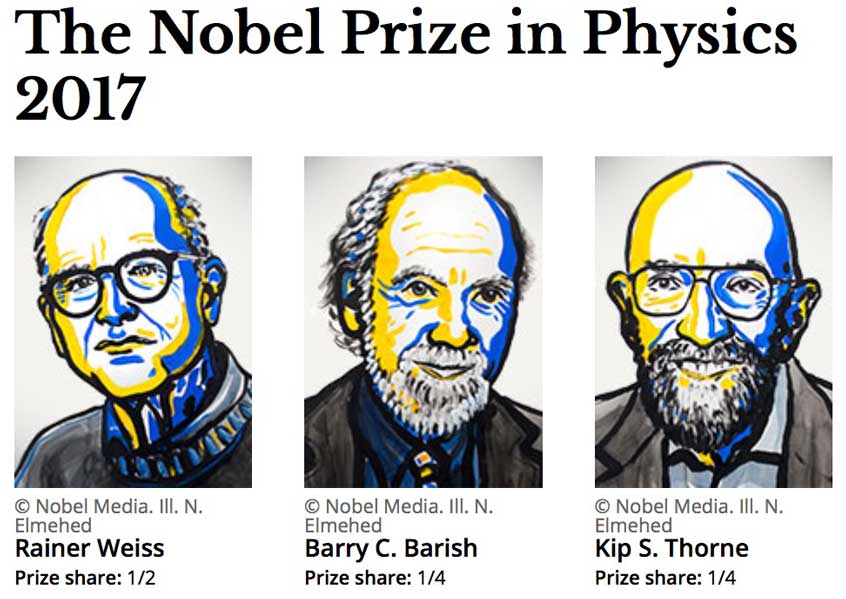The Royal Swedish Academy of Sciences has decided to award the Nobel Prize in Physics 2017 with one half to
Rainer Weiss
LIGO/VIRGO Collaboration
and the other half jointly to
Barry C. Barish
LIGO/VIRGO Collaboration
and
Kip S. Thorne
LIGO/VIRGO Collaboration
“for decisive contributions to the LIGO detector and the observation of gravitational waves”
It is well deserved. I remember the excitement and rumours that were swirling about prior to the formal LIGO announcement, and was even blogging about LIGO back in Jan 2016. So the award of a Nobel Prize is indeed a reflection of the excitement that prevailed.
The Nobel Prize for Physics is perhaps to some extent the highlight of the annual Nobel awards. You might perhaps suggest that I’m being a tad biased, and perhaps I am, but if you look at a list of past winners then, as a contrast to any other Nobel prize category, the names are all well-known even outside the physics community – Albert Einstein, Niels Bohr, Marie Curie, Erwin Schrödinger, Werner Heisenberg, Max Planck, Guglielmo Marconi, Richard Phillips Feynman, and many more.
OK, enough preamble, let’s move on to some details.
(Side note: the information below has been shamelessly cut and pasted from the official press release)
Who?
Rainer Weiss, born 1932 in Berlin, Germany. Ph.D. 1962 from Massachusetts Institute of Technology, MIT, Cambridge, MA, USA. Professor of Physics, Massachusetts Institute of Technology, MIT, Cambridge, MA, USA.
Barry C. Barish, born 1936 in Omaha, NE, USA. Ph.D. 1962 from University of California, Berkeley, CA, USA. Linde Professor of Physics, California Institute of Technology, Pasadena, CA, USA
Kip S. Thorne, born 1940 in Logan, UT, USA. Ph.D. 1965 from Princeton University, NJ, USA. Feynman Professor of Theoretical Physics, California Institute of Technology, Pasadena, CA, USA
The LIGO/VIRGO COLLABORATION home page is here.
Gravitational waves finally captured
On 14 September 2015, the universe’s gravitational waves were observed for the very first time. The waves, which were predicted by Albert Einstein a hundred years ago, came from a collision between two black holes. It took 1.3 billion years for the waves to arrive at the LIGO detector in the USA.
The signal was extremely weak when it reached Earth, but is already promising a revolution in astrophysics. Gravitational waves are an entirely new way of observing the most violent events in space and testing the limits of our knowledge.
LIGO, the Laser Interferometer Gravitational-Wave Observatory, is a collaborative project with over one thousand researchers from more than twenty countries. Together, they have realised a vision that is almost fifty years old. The 2017 Nobel Laureates have, with their enthusiasm and determination, each been invaluable to the success of LIGO. Pioneers Rainer Weiss and Kip S. Thorne, together with Barry C. Barish, the scientist and leader who brought the project to completion, ensured that four decades of effort led to gravitational waves finally being observed.
In the mid-1970s, Rainer Weiss had already analysed possible sources of background noise that would disturb measurements, and had also designed a detector, a laser-based interferometer, which would overcome this noise. Early on, both Kip Thorne and Rainer Weiss were firmly convinced that gravitational waves could be detected and bring about a revolution in our knowledge of the universe.
Gravitational waves spread at the speed of light, filling the universe, as Albert Einstein described in his general theory of relativity. They are always created when a mass accelerates, like when an ice-skater pirouettes or a pair of black holes rotate around each other. Einstein was convinced it would never be possible to measure them. The LIGO project’s achievement was using a pair of gigantic laser interferometers to measure a change thousands of times smaller than an atomic nucleus, as the gravitational wave passed the Earth.
So far all sorts of electromagnetic radiation and particles, such as cosmic rays or neutrinos, have been used to explore the universe. However, gravitational waves are direct testimony to disruptions in spacetime itself. This is something completely new and different, opening up unseen worlds. A wealth of discoveries awaits those who succeed in capturing the waves and interpreting their message.
Further Details
- Popular Science Background –Pdf 1811 kB
- Scientific Background – Pdf 2338 kB
Images
- Image – Gravitational waves (pdf 162 kB)
- Image – Two black holes (pdf 508 kB)
- Image – LIGO (pdf 1825 kB)
- Image – LIGO in the USA (pdf 1734 kB)

The tools of photonics, which allow you to manipulate light with exquisite precision and opened the way for new industrial and medical applications, have been recognized with the award Nobel Prize in Physics in 2018. The Swedish Academy of Sciences has awarded the award to the American Arthur Ashkin, the French Gérard Mourou and the Canadian Donna Strickland, who becomes the first woman to win the Nobel Prize in Physics since 1963.